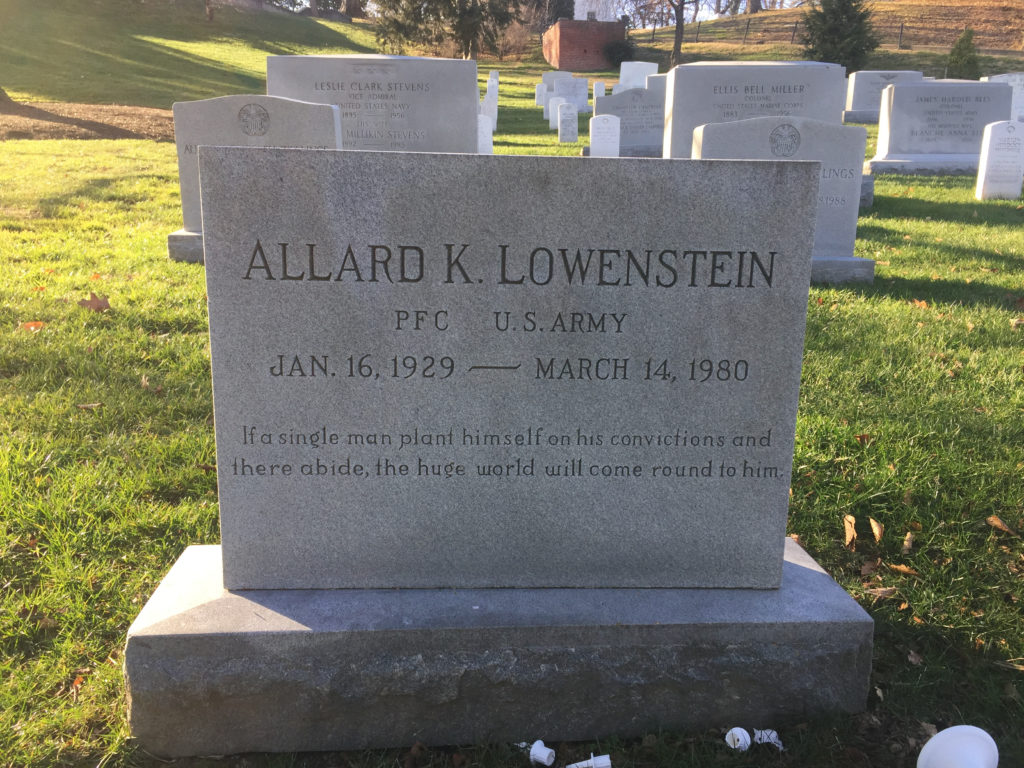Erik Visits an American Grave, Part 832
This is the grave of Allard Lowenstein.

Born in 1929 in Newark, Lowenstein grew up in a Jewish immigrant family in the time and place so memorably written about by Philip Roth. A very smart kid, Lowenstein graduated from the Horace Mann School in New York and then went to the University of North Carolina for college, followed by Yale for law school, which he completed in 1954.
Lowenstein was always interested in politics. While at UNC, he worked for Senator Frank Porter Graham as an aide. Graham was about as progressive as a white politician in the South could be in these years and he was a big influence on his student. Never all that interested in practicing law, Lowenstein went into politics to fight for social justice. He was on Hubert Humphrey‘s staff as a foreign policy assistant in 1959. That same year, he decided to go visit southern Africa to learn about the apartheid regime for himself. He went to Naimbia without almost anyone knowing it, came back, and wrote up a scathing report of the racism and violence the South Africans were committing in what was then called South-West Africa. He returned to the U.S., went on a speaking tour around college campuses about the horrors of the South African government, and then wrote a book called A Brutal Mandate about it with Eleanor Roosevelt writing the introduction. He also did a lot of work recruiting northern students to go to Mississippi for Freedom Summer in 1964. During these years, he also worked at Stanford University as the dean of a residential college. He also would teach at North Carolina State University and City College of New York.
In 1968, already very critical of the Vietnam War, Lowenstein helped start the Dump Johnson movement and tried to convince his friend Bobby Kennedy to challenge LBJ. Of course, that didn’t happen immediately. He then turned to George McGovern, but the senator from South Dakota refused as well. So the movement turned to Eugene McCarthy for that purpose and of course he agreed. McCarthy was a weirdo and not all that progressive on most issues, but he served the purpose Lowenstein and others were looking for. Once Johnson dropped out after the Tet Offensive and his near-defeat in the New Hampshire primary, Kennedy got in, but Lowenstein remained working for McCarthy, respecting what he had done. Lowenstein was seen as a sort of political guru for the young anti-war kids. David Broder said of him,”It is beyond dispute that he brought more young people into American politics than any individual of our time.”
In 1968, Lowenstein also ran for Congress. He won, but was gerrymandered out of his seat in 1970. He ran in a different district in 1972 against the conservative machine Democrat John Rooney and lost that too, though he ran for the general on the Liberal Party ticket and won 28 percent of the vote. He was a loud critic of Richard Nixon at this time. In 1971, he headed Americans for Democratic Action and Nixon despised him. Lowenstein was lucky enough to occupy the #7 spot on Nixon’s Enemies List.
So Lowenstein was a progressive on many issues. But he had some character flaws. Specifically, Donald Rumsfeld was his best friend, having met when they were congressional aides in the late 50s. In fact, he actually attended the 1964 Republican National Convention as Rummy’s guest. He was also close buddies with William F. Buckley. In fact, Buckley actually endorsed Lowenstein’s run for a Long Island congressional seat in 1974 and 1976. I really don’t understand what was going on here. Washington insider friend stuff I guess. Anyway, Lowenstein almost won in 74 in what was a very Republican district. Lowenstein also became a RFK assassination truther and appeared on Buckley’s Firing Line in 1975 to make claims that Sirhan Sirhan did not kill his old friend.
In 1977, the Carter administration named Lowenstein the head for the U.S. delegation to the annual session of the U.N. Commission on Human Rights. He was also U.S. Representative for Special Political Affairs to the United Nations.
Lowenstein was married and had kids, but scholars have speculated that he was gay and in the closet. His private writings are filled with discussions of his desires for intense relationships with men and he was known for what today would be considered quite inappropriate behavior with attractive young men in his orbit, either spending time in bed together or getting into wrestling matches, though there’s no evidence any of this led to outright sexual behavior. He seems to have been moving toward coming out of the closet toward the end of his life. He got involved in gay rights causes in the late 70s. In his support for Ted Kennedy‘s primary run in 1980, he proved very effective at fundraising in gay Democratic clubs in Florida and California.
In 1980, Lowenstein was in his Manhattan office. One of his former students from Stanford, Dennis Sweeney, walked in and shot him dead. Sweeney was mentally ill and of course being the United States, had access to guns. There’s also evidence that Lowenstein had made a pass at Sweeney. However, the more concrete reason seems to be that Sweeney thought Lowenstein was an undercover state agent seeking to destroy the civil rights movement and other leftist causes. This was indeed pretty insane. Lowenstein was 51 years old. Buckley and Ted Kennedy gave eulogies at his funeral.
Allard Lowenstein is buried on the confiscated lands of the traitor Lee, Arlington National Cemetery, Arlington, Virginia.
This grave visit was funded by LGM reader donations. Many thanks! If you would like this series to visit more people on Nixon’s Enemies List, you can donate to cover the required expenses here. Edwin Guthman is in Culver City, California and Maxwell Dane is in Queens, New York. Previous posts in this series are archived here.


